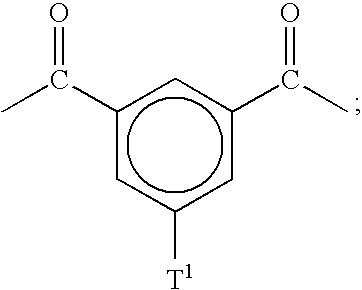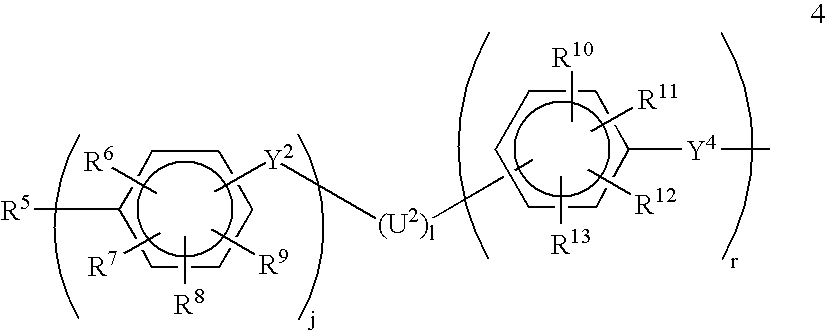Fluorinated Polymer Blocks For PEM Applications
a technology of fluorinated polymer blocks and pem, which is applied in the direction of electrochemical generators, ion exchangers, ways, etc., can solve the problems of reducing the lifetime of polymer electrolyte membranes, imposing rather strict limitations on material choices for these membranes, and relatively few polymer systems that provide even marginally acceptable materials. , to achieve the effect of higher proton conductivity
- Summary
- Abstract
- Description
- Claims
- Application Information
AI Technical Summary
Benefits of technology
Problems solved by technology
Method used
Image
Examples
example 1
[0073]About 17.48 g (30 mmol) of (19a) and 20 g (≈1 mmol) of the polymer having formula 20 are placed in a 250 ml flask equipped with a mechanical stirrer, a nitrogen inlet and a reflux condenser. 350 ml of anhydrous and deoxygenated NMP are then added under a constant flow of nitrogen. The mixture is heated to 200° C. for 16 hours and is then poured after cooling to room temperature into 31 of isopropanol to precipitate the crude polymer. After filtration and drying the polymer is purified by means of Soxhlett extraction, first with chloroform and subsequently with water. The resulting polymer is a polymer having formula 18a with x=40 (from Example 1.2) and y=33.
[0074]A membrane is cast from a DMSO solution onto a glass substrate. After the removal of the solvent at 120° C. and annealing at 200° C. a membrane is obtained which is then proton exchanged by placing it into a 1 molar sulfuric acid for 24 hours and washing it with D.I. water until the washing water is pH neutral.
examples 2 and 3
[0075]Polymers designated as polymers 18b and 18 are prepared in an analogous manner to the polymer having formula 18a with monomers (19b) and (19c) being substituted for monomer 19a, respectively.
[0076]Membranes are cast from a DMSO solution onto a glass substrate. After the removal of the solvent at 120° C. and annealing at 200° C. membranes are obtained which are proton exchanged by placing them into a 1 molar sulfuric acid for 24 hours and washing them with D.I. water until the washing water is pH neutral.
3. Triblocks with Perfluorosulfonic Acid Side Chains:
[0077]
Synthesis of the perfluorocyclobutane side chain monomer
[0078]
[0079]About 100 g (0.326 mol) of 1,1,1-tris(4-hydroxyphenyl)ethane (THPE), 45.05 g (0.326 mol) of potassium carbonate and 300 ml of anhydrous DMSO are added to a 1000 ml flask equipped with a Dean-Stark trap, reflux condenser, a nitrogen inlet and a mechanical stirrer. About 80 ml of cyclohexene is used as the azeotroping agent. The mixture is heated under a ...
example 4
Synthesis of Triblocks Having Sulfonated Perfluoro-Cyclobutane Side Chains
[0080]About 41.0 g (2.0 mmol) of polymer 20 with x=40 (on average), 52.115 g (60.0 mmol) of (19d), 27.725 g (61.0 mmol) of 4,4′-difluoro-3,3′-di(potassium sulfonate)-benzophenone and 21.08 g (0.153 mol) of potassium carbonate, 300 ml anhydrous DMSO, 700 ml anhydrous NMP and 100 ml of anhydrous cyclohexene are added to a 2000 ml flask equipped with a Dean-Stark trap, reflux condenser, a mechanical stirrer and a nitrogen inlet. The mixture is refluxed at 140° C. for 4 hours under nitrogen. The benzene is removed and the mixture is heated for further 36 hours at 160° C. The mixture is filtered, diluted with DMSO and acidified with concentrated HCl. The solution is then poured into an excess amount of methanol under vigorous stirring. The precipitated solid is washed with methanol and dried at 100° C. in vacuum. In order to purify the triblock, a Soxhlett extraction first with chloroform and subsequently with wate...
PUM
| Property | Measurement | Unit |
|---|---|---|
| Electrical conductor | aaaaa | aaaaa |
| Hydrophobicity | aaaaa | aaaaa |
Abstract
Description
Claims
Application Information
 Login to View More
Login to View More - R&D
- Intellectual Property
- Life Sciences
- Materials
- Tech Scout
- Unparalleled Data Quality
- Higher Quality Content
- 60% Fewer Hallucinations
Browse by: Latest US Patents, China's latest patents, Technical Efficacy Thesaurus, Application Domain, Technology Topic, Popular Technical Reports.
© 2025 PatSnap. All rights reserved.Legal|Privacy policy|Modern Slavery Act Transparency Statement|Sitemap|About US| Contact US: help@patsnap.com



